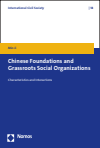Zusammenfassung
Die Autorin untersucht, wie und warum chinesische Stiftungen mit sozialen Basisorganisationen (SOs) interagieren. Neben gut dokumentierten empirischen Untersuchungen in China wird die Studie mit anekdotischen Belegen durchgeführt, die die Autorin über einen Zeitraum von zehn Jahren von 2008 bis 2019 sammelte, als die chinesischen Stiftungen ihre Interaktion mit anderen SOs begannen.
Die Ergebnisse zeigen, dass chinesische Stiftungen mit Basis-SOs auf sechs verschiedene Arten interagieren, nämlich über Spezialfonds, gemeinsames Fundraising, High-Engagement Grantmaking, Zuwendungen an Projekte, Zuwendungen an Organisationen und Zuwendungen an Einzelpersonen. Allerdings deckt sich die Förderlogik chinesischer Stiftungen nicht mit den Bedürfnissen von gemeinnützigen Organisationen an der Basis, weil sie die Schwierigkeiten des jeweils anderen nicht vollständig verstehen und weil ihr Fokus und ihr Entwicklungsweg nicht derselbe sind, was zu weniger Interaktion führt.
Dieses Buch bietet neue und inspirierende Einblicke für Wissenschaftler und Studenten des aufstrebenden und florierenden dritten Sektors in China. Es ist nicht nur für Wissenschaftler interessant, sondern spricht auch die Praktiker an, die in Chinas drittem Sektor arbeiten.
Abstract
This study explores how Chinese foundations interact with grassroots social organisations (SO) and why Chinese foundations act the way they do. In addition to involving well-documented empirical investigations in China, the study was conducted using anecdotal evidence accumulated over a 10-year period from 2008 to 2019, when Chinese foundations started their interaction with other SOs.
The findings show that Chinese foundations interact with grassroots SOs in six different ways, namely special funds, joint fundraising, high-engagement grantmaking, and awarding grants to projects, organisations and individuals. However, Chinese foundations’ grantmaking logic does not overlap with the needs of grassroots SOs, because they do not fully understand each other’s difficulties and because their focus and development paths are not the same, which results in less interaction.
This book provides new and inspiring insights for scholars and students of China’s emerging and flourishing third sector. It will not only interest those in academia, but will also appeal to those working in China’s third sector.
- Kapitel Ausklappen | EinklappenSeiten
- 23–42 1 Introduction 23–42
- 57–77 3 Methodology 57–77
- 113–147 5 Understanding cooperation from the perspective of both foundations and grassroots sos 113–147
- 223–236 Bibliography 223–236

